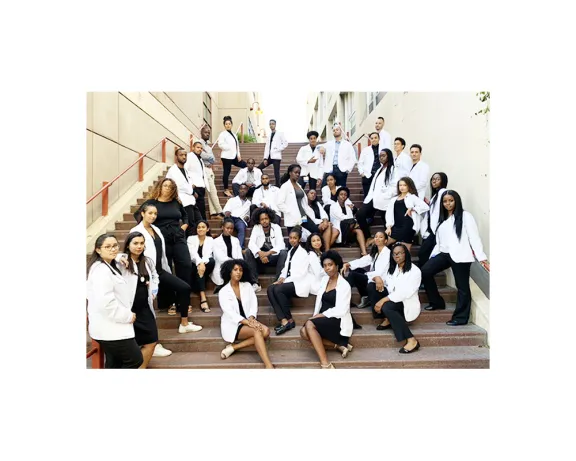
This Date in UCSF History: Minority Enrollees Climb Dramatically
Originally published on September 14, 1986. In a dramatic reversal of last year’s disappointing showing, the School of Medicine enrolled 39 underrepresented minority students this fall. The figure represents more than a 100 percent increase over 1985, when 19 were admitted-by far the lowest total recorded here in several years.
Mexican American students showed the most striking increase, going from five to 18 enrollees. African Americans also gained significantly, rising to 15 students from nine in 1985. These totals are the highest in many years for these racial groups and re-established UCSF’s School of Medicine as a national leader in minority admissions.
“We’re very pleased with the improvement,” said Dean Rudi Schmid. “And I’m very pleased also with (the entering minorities’) scholastic records.”
A revitalized recruitment program, involving students and faculty, made the difference this year, said Dr. Michael Drake, associate professor of ophthalmology and head of the admissions panel which initially screens most minority applications.
After underrepresented minority admissions figures plummeted last fall, Schmid was accused of not being sufficiently sensitive to the importance of minority enrollment for the school.
But Schmid provided financial support for drawing in qualified minority students, Drake said. “In fact, and in deed, the dean has supported the effort well, and very actively,” he said.
Schmid called Drake the “architect” of the successful effort and credited Associate Dean for Admissions Lloyd (Holly) Smith; John Watson, professor of biochemistry; and Associate Dean for Student and Curricular Affairs David Altman with important contributions.
Students played a key role in many of the successful recruitment efforts, said David Campa, a third-year medical student and member of the admissions committee. Student pressure led to the administration’s new recruitment initiatives, he said.
A detailed analysis of last year’s admissions downturn published in Synapse last December made a major impact on raising consciousness about the severity of the problem, Campa said.
National trends
A number of national trends contributed to the 1985 affirmative action debacle. Schools around the country felt the pinch of a 7.8 percent decline from the previous year in applications from underrepresented minorities (defined as Mexican Americans, mainland Puerto Ricans, blacks and Native Americans), according to the Association of American Medical Colleges.
Analysts believe the decline was caused by a variety of economic factors.
Doctors’ earning power is not increasing at the same rate as it was in the past, perhaps causing a reevaluation by potential applicants looking forward to seven or more years of training and tens of thousands of dollars in loans.
By the same token, other professions, such as law and engineering-which have shorter training periods but seem to be maintaining their income growth — are increasingly attractive. Yet UCSF suffered a 14 percent decline in minority applications-nearly twice the national rate.
And other leading medical schools, including and Stanford, were able to increase their minority populations despite the decline in applications. This raised grave concerns among students and faculty alike that something was amiss here.
This year, Drake said, UCSF got about the same number of applications as in 1985.
But the quality had improved. Drake attributed this higher quality to more serious recruitment efforts, including 10 trips to various campuses nationwide, letters to promising candidates and phone calls from the dean to convince the top minority students to come here.
A particularly successful innovation, say students and faculty, was a weekend workshop for minority applicants. The weekend was designed to introduce candidates to the school and make them feel welcome.
Many faculty and students participated, Drake said, which made the event a big morale booster. It reinforced the commitment to a successful affirmative action program at all levels. Twenty of 23 students who attended the workshop chose UCSF, Drake said. “We did a great job of convincing people.” In a typical year, about 60 percent of accepted minorities enroll here, Drake said.
Although the school is one of the best in the nation academically and enjoys a number of other appealing qualities-location and lack of tuition among them-minorities qualified to enroll here are usually sought after by other leading institutions. But this year, 75 to 80 percent of accepted minority students chose UCSF.
“Now we have to sustain it,” Schmid said. The knowledge gained during the successful effort may point the way to preventing any future lapses in affirmative action, he added.
The successful techniques will be extended to the coming year, Drake said. Already, visits to woo new applicants have been made to Harvard, North Carolina and Texas.
Campa said the administration deserves credit for its efforts last year, and that the true test of the administration’s long-term commitment will be reflected in the continuation of this increase in minority students. “I just hope this trend will continue,” he said.
“Now we have to get some more role models for these minority groups on the faculty,” said Dean Schmid. Historically, affirmative action for faculty members has lagged far behind the figures for students not only in the School of Medicine, but in most of higher education. Currently the school has only a handful of faculty members from racial minorities.



